Athletic Revolution at Full Throttle Athletics: A Revolution From Over Zealous Parents and Coaches In Youth Sports
By Robert D. Blackford
There are certain times in your life that give you pause to stop and say: WOW…..ALL I CAN SAY IS WOW!
You aren’t sure if you should be mad, embarrassed or ashamed…this is one of those times.
Read this article on youth sports from ESPN:
In short, it’s the misdirected rant, spit, grit and drill sergeant-esq pep talk of a football coach…directed at (WAIT FOR IT, WAIT FOR IT) 8 year olds in Frisco, TX. Ugh.
As a 10 year resident of Frisco this article surprised me but wasn’t entirely shocking. Our family has participated in organized team youth sports, playing coaching and supporting from ages 4 on for our two children.
Are we passionate?
Yes.
Do we offer cheers, advice and criticism at practice and games?
Absolutely.
Is it as important to participate, learn, grow, and both lose and win? All equally. But there is a level where it’s beyond too far. The article above is evidence.
A world apart from the ridiculous behavior referenced in the ESPN article is the weekly program our age 10 and 6 children participate in: Athletic Revolution Frisco (AR). Agility, health, strength, fitness, coordination, and flexibility are the byproducts of what the kids think is nothing more than…well FUN.
We joined what appeared to be this professional yet simple, no frills gym at Full Throttle Athletics in Frisco/ Little Elm in 2010-2011. We learned about flexibility, nutrition, strength and endurance. Then we eagerly signed up the kids when the gym launched Athletic Revolution, their youth sports program.
After personally observing the interaction with the AR coaches, I can say it’s a revolution from the rant above. Positive reinforcement, actual hands-on coaching and mentoring are the fundamentals taught to AR Champions.
Results: faster, stronger and smarter to form the foundation of some lifelong habits. Their progressive nature and sound methodology coupled with everyday sporting fun makes for a great combination. Now the kids look at it like a trip to the park!
Want a youth sports revolution from the norm, checkout AR at Full Throttle. You won’t be disappointed.
– Robert D. Blackford





